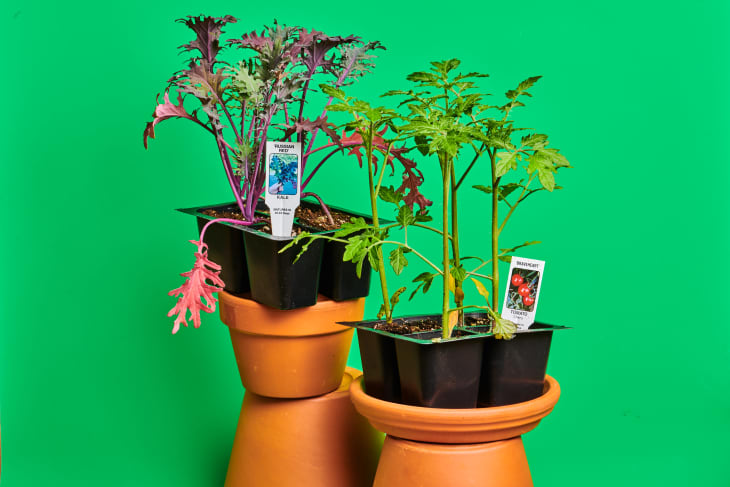Have a Small Balcony? Your Best Gardening Bet Is Salad Greens

So you’ve decided to grow tiny victory garden—congrats! You’ve already done your homework and gathered your supplies, and now it’s planting time. Those who only have a windowsill already got the rundown on growing mint, and now it’s time to bring our recommendations to those of you working within a small balcony space. Even if you only have room for just one or two containers on your balcony, you’d be surprised at how much you can work with in that setting: lots of vegetables can be successfully grown in containers, and with so many compact varieties on the market, the options might seem overwhelming. One consideration to keep in mind, as always, is your sunlight situation.
According to Maureen O’Brien at Brooklyn Botanical Garden, this is a good rule of thumb: Outdoor areas that receive less than 6 hours of sunlight a day are best suited for plants grown for their leaves (so, everything from herbs to lettuces to kale). Meanwhile, spaces that receive more than 6 hours of sun (and preferably closer to 8-12) can get away with fruiting vegetables, such as zucchini, cucumbers, beans, and tomatoes. A fruiting vegetable in partial shade will grow slowly and likely not produce much, if any, fruit, and a leafy green like arugula grown in full sun might bolt (go to seed) quickly, altering the flavor of the leaves.
For Lower-Light Balconies, Go for Salad Greens
If your balcony spends most of the day in the shadow of trees or a surrounding high-rise, your best bet is sticking with salad greens. Amy Pennington, who plans and installs edible gardens for homes and businesses, loves growing lettuces because they come to maturity quickly (about 45 days), they’re versatile in the kitchen, and their shallow root systems make them an ideal fit for small containers. “I use several long, shallow containers, about 6-inches deep, maybe 4-inches wide, and 3-feet long, and in just that one container, you can fit 6 or 7 heads of lettuces,” says Pennington. “That’s my favorite place to start.” Heirloom lettuce, arugula, and spinach all germinate fairly quickly from seed, so tracking down a plant start might not even be necessary, and the number of varieties out there—from buttercrunch to bok choy—will definitely keep things interesting. Given their quick maturity, you can also succession-plant, or continuously start new rounds of seeds after harvesting.
Recipes with Salad Greens
For Higher-Sun Balconies, Try Tomatoes
If you do have a full sun setup, hooray! You have a few more options—but before you get carried away, it’s important to think about a plant’s size. You might theoretically be able to grow a full-size plant thick with fat, juicy Cherokee Purple tomatoes, but indeterminate types will keep growing and sprawling as long as you let them, which means your balcony might have a “Little Shop of Horrors” vibe by the end of the summer. A better bet will be a compact, patio-friendly cherry tomato bush-type variety bred specifically for container gardening, of which there are many (some are even bred for cooler climates, like the New Yorker). Look for determinate types, which stop growing after reaching a specific size, thus avoiding the shaggy Audrey II situation mentioned earlier. And be sure you have a pot that can accommodate the size of your plant’s root system: even dwarf varieties need room to grow. O’Brien recommends a pot at least 18-inches wide and 18-inches deep for one plant. Tomatoes are heavy feeders, so if you can get your hands on a bit of fertilizer or plant food, that can’t hurt. Pennington prefers an all-purpose, organic fertilizer; O’Brien recommends compost or fish emulsion.
At this point in the season, it’s a bit late to start tomato seeds, so you’ll be a little limited by the availability of plant starts in your area. But tomatoes are, by far, the most popular and beloved home gardening veggie—so odds are your local nursery or garden center should have plenty of them, and your neighbors might even have extras, if you ask nicely.
P.S.: If this is your first go, it won’t hurt to brush up on some basic tomato care tips. They aren’t terribly hard to grow, but it’s good to know how to avoid certain fungi, blight, and pests, when to prune, and how often to water them. Oh, and go ahead and set up those tomato cages as soon as you plant them—you’ll be surprised at how quickly those tiny-looking plants become taller than you.
Recipes with Tomatoes
A Shopping List for Growing Salad Greens or Tomatoes on Your Balcony
- Gronomics Rustic Planter Box, $172 from Home Depot
- Novelty Plastic Flower Box Planter, $19.20 from Amazon
- Dynamic Design Newbury Window Box, $7.97 from Home Depot
- Miracle-Gro Potting Soil Mix, $9.97 from Home Depot
- Fiskars Ergo Trowel, $7.84 from Amazon
Where to Buy Salad Greens & Tomatoes
- Tomato Seeds (various varieties), start at $1.69 from True Leaf Market
- Cherry Tomato Seeds, $4 from Urban Leaf
- Be My Baby Cherry Tomato Seeds, $3.75 from Terrain
- Homegrown Heirloom Seeds Lettuce & Greens Kit, $19.99 from Amazon
- Red Fox Organic Arugula Seeds, $3.49 from Etsy
- Gurney’s Lettuce Premium Blend Seeds, $6.67 from Home Depot